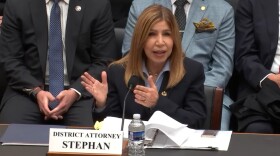At $68,000 per year, George Washington University in Washington D.C. is one of the most expensive schools in the country, and yet some students — most of whom receive financial aid — still don't have enough to eat every week.
The university, bolstered by a national survey by the College and University Food Bank Alliance, discovered that nearly half of its student population matched the national rate of 48 percent of respondents who experienced food insecurity.
So the school opened a food pantry for students, joining over 300 other schools across the nation that have done the same.
College meal plans vary throughout the country, from traditional dining hall settings to a la carte combinations. And some plans focus on options all around the city, says Tim Miller, associate dean of students at George Washington, which is embedded in a well-to-do neighborhood of the nation's capital.
"The population at GW does a lot in the city," Miller says. "They intern a great deal. So we have a plan that allows students to meet that need." He adds that many of the university's students also cook for themselves.
The school's food pantry is unmarked. Students fill out forms that list their email addresses and student ID numbers, but they do not have to give their names or discuss their finances.
"One of the things that we learned from talking to all the other universities that we spoke to this summer was one of the concerns for students is anonymity around this and being able to feel like they can use us without having any judgment," Miller says.
He describes one student who walked in terrified of not knowing what the pantry would be like and was overjoyed and brought to tears when she saw it was like a grocery store.
"She felt like she could go to every shelf and take what she most needed versus being directed you have to take this, this and this. But the fact that there's an empowering part of this is really something we've heard a lot about from the students who've used it so far," he says.
And students are using it. In September, the university did a soft-launch of the food pantry, without any advertising, and 21 students signed up immediately. Now, 147 students are enrolled in the program.
"We have gotten amazing notes back from students about how this has been a blessing to them and how this really has helped them focus on what they thought they could be able to do here," says Miller.
Because of George Washington's sticker price, Miller says it's important to listen to students.
"We want to have faith in our students that if they say they need this, that they do and trust them to take what they need," he says, adding that the school has focused a lot on affordability and tries to do everything possible, including partnering with other organizations, to provide support.
But the growing number of food pantries on college campuses may well be taken as yet another sign that a college education in general is just too expensive.
Miller says the idea is a positive response to a really challenging situation, but it's not the ultimate solution.
"I think we have to look at, how do we help our students afford it? And how do we manage the cost of higher education for all students? We're also looking for what that final solution is."
Copyright 2016 NPR. To see more, visit http://www.npr.org/.






